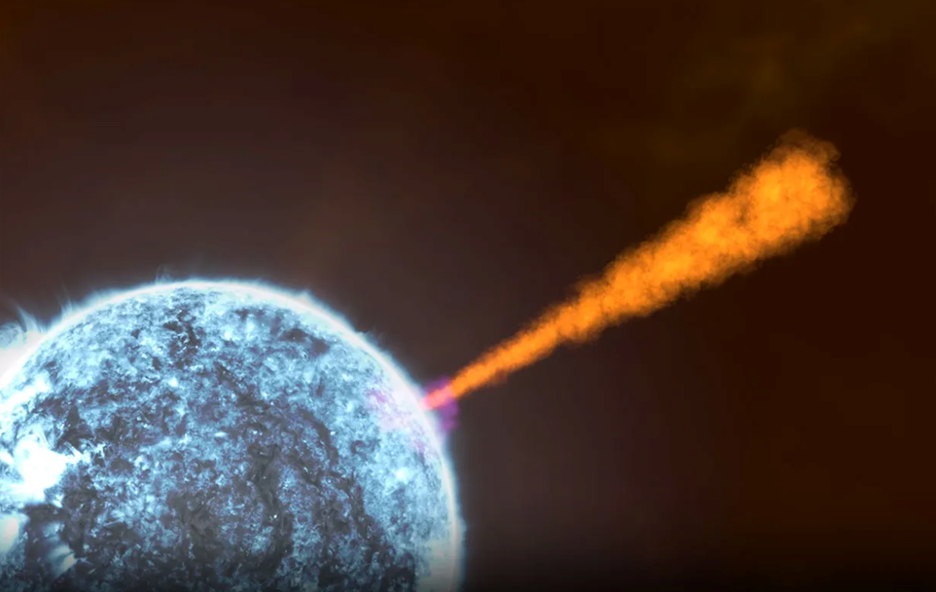The collapse of rapidly rotating massive stars is known to launch collimated jets of material moving at nearly the speed of light. These phenomena produce high energy gamma-ray light that astronomers detect using space satellites and refer to them as gamma-ray bursts (GRBs). The recent GRB 221009A is the most extreme gamma-ray burst detected in 50 years of observations.
Views 3647
Reading time 4 min
published on Nov 20, 2023
Gamma-ray bursts (GRBs) are short duration transient phenomena lasting from a few seconds to hundreds of seconds. These bursts are localized on the sky using gamma-ray detectors onboard satellites orbiting Earth. The satellites pinpoint the direction of the burst, allowing astronomers to rapidly point their telescopes and observe the emission across the light spectrum.
GRBs were first discovered serendipitously in 1967 by the Vela Satellites, which were actually monitoring for nuclear weapons tests on Earth. It wasn’t until 1973 that these phenomena were introduced to the rest of the world, as their earlier discovery was highly classified. The multiple Vela satellites were able to triangulate that the signal was coming from somewhere other than Earth, leading to their origin remaining a mystery. It took decades for their cosmological nature to be agreed upon, and more than a hundred models had been put forth to explain their emission in that time period.
Fortunately, astronomers have now identified thousands of GRBs, leading to the Golden Age of studying the GRB mystery. Thanks to the Compton Gamma-ray Observatory, Fermi Gamma-ray Space Telescope, and the Neil Gehrels Swift Observatory, astronomers were able to understand that these explosions are created by the collapse of massive stars. The stellar collapse is thought to form a black hole, which rapidly accretes matter and launches it outwards as a narrow beam of material (a jet) moving at nearly the speed of light. The jet of material produces both the gamma-ray radiation that signals the GRB as well as broadband emission all the way from radio waves to gamma-rays. The broadband emission component is referred to as the ‘afterglow’ and is produced as the jet collides with the environment surrounding the exploding star.
The afterglow allows us to determine the total energy of the jet as well as its collimation (how wide or how narrow it is). Astronomers have identified that GRBs are highly collimated (narrow) outflows, with a typical opening angle of a few degrees. This narrow angle means that we only observe GRBs that are pointed directly at us, like waiting for a lighthouse to point in your direction.
On October 9th, 2022, gamma-ray satellites detected an extremely bright GRB lasting for almost 10 minutes. The GRB was so bright (~70 times brighter than the previous record holder) that astronomers initially determined that it must be coming from within our own Galaxy at close proximity. As further observations were obtained, it became clear that this explosion was a GRB at a distance of more than 2 billion light-years away. Quickly, it was determined that GRB 221009A is the most energetic GRB we had ever seen, and the rate of similar events occurring at this proximity to Earth was once in a millennium or more. Based on these calculations, we were extremely fortunate to have observed this explosion in our lifetime, and even more fortunate that it was directed towards Earth.
While at first the GRB seemed typical, despite the extreme brightness and rarity, when modeling the overall emission out to ~100 days after the explosion, we discovered that it had some distinctive properties. We found that the GRB jet was characterized by a peculiar decrease in energy with increasing angle away from the core of the jet. This energy profile allowed us to explain the decrease in brightness of the emission over time, and the fact that we never observed the ‘edge’ of the jet.
In typical GRBs, we measure the width of their jet by identifying the time when the emission begins to decrease in brightness more rapidly. At this time, there is no other matter emitting light in our direction, leading to the rapid drop in brightness, known as a ‘jet-break’. However, GRB 221009A never displayed this sharp drop-off, requiring instead a very wide jet (>15-20 degrees), compared to other GRBs (~5-10 degrees). We have still not observed a ‘jet-break’ in GRB 221009A out to more than 200 days after the explosion.
There is still a lot of work left to be done to understand the consequences of these jet properties. There is evidence that the most extreme and energetic GRBs may share similarly wide jets, which could imply they are formed by similar explosions. The most pressing issue though, is how to produce such a wide and structured jet in numerical simulations of exploding stars. This will help us to understand the type of star that exploded and the degree of mixing of material as the jet drills through the layers of the star.
Original Article:
Brendan O’Connor et al., A structured jet explains the extreme GRB 221009A. Sci. Adv. 9, eadi1405 (2023). DOI:10.1126/sciadv.adi1405
 Earth & Space
Earth & Space



